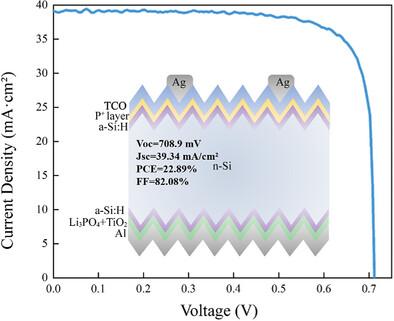Self-Diffusion Effect Assisted TiO2/Li3PO4 Electron Selective Passivating Contact in Silicon Solar Cells Approaching 23% Efficiency
IF 13
2区 材料科学
Q1 CHEMISTRY, MULTIDISCIPLINARY
引用次数: 0
Abstract
Carrier selective contacts with passivation effects are considered to have a significant influence on the performance of crystalline silicon (c-Si) solar cells. It is essential for electron selective contact materials to meet the requirements of ultra-low contact resistance and excellent passivation effects. This work introduces a stack layer of Lithium Phosphate (Li3PO4) /Titanium Dioxide (TiO2) as a new electron selective passivating contact. It is found that the stack achieves an impressive contact resistivity (ρc) of 0.128 mΩ cm2 on n-type c-Si substrates with resistivity ranging from 1 to 3 Ω cm (14.6 mΩ cm2 for the n-Si/a-Si:H/Li3PO4/TiO2/Al contact). Furthermore, it effectively reduces the surface recombination parameter (J0) to less than 4 fA by incorporating a 6 nm a-Si:H(i) layer. The characterization of the n-Si/Li3PO4/TiO2 interface reveals that phosphorus diffusion into silicon plays a crucial role in achieving the ultra-low contact resistivity, while the presence of PO43− groups helps in fixing hydrogen atoms to maintain the desired chemical passivation effect. Finally, a silicon heterojunction solar cell (SHJ) with a rear full-area configuration of a-Si:H/Li3PO4/TiO2/Al is successfully demonstrated achieving an impressive power conversion efficiency of 22.89%. The result proves the efficacy of employing hydrogen-rich low-work function metal oxide stacks as electron selective passivating contacts.

硅太阳能电池中自扩散效应辅助 TiO2/Li3PO4 电子选择性钝化触点的效率接近 23
具有钝化效应的载流子选择性接触被认为对晶体硅太阳能电池的性能具有重要影响。电子选择性接触材料必须满足超低接触电阻和优异钝化效果的要求。本研究采用磷酸锂(Li3PO4)/二氧化钛(TiO2)叠层作为新型电子选择性钝化接触材料。研究发现,在电阻率范围为 1 至 3 Ω cm 的 n 型晶体硅衬底上,这种堆叠层的接触电阻率 (ρc)达到了惊人的 0.128 mΩ cm2(n-Si/a-Si:H/Li3PO4/TiO2/Al 接触层为 14.6 mΩ cm2)。此外,通过加入 6 nm 的 a-Si:H(i)层,它还能有效地将表面重组参数 (J0) 降低到 4 fA 以下。n-Si/Li3PO4/TiO2 界面的特性分析表明,磷向硅中的扩散对实现超低接触电阻率起着至关重要的作用,而 PO43- 基团的存在则有助于固定氢原子,从而保持理想的化学钝化效果。最后,一种采用 a-Si:H/Li3PO4/TiO2/Al 后部全面积配置的硅异质结太阳能电池 (SHJ) 得到了成功验证,其功率转换效率达到了惊人的 22.89%。该结果证明了采用富氢低工作函数金属氧化物堆作为电子选择性钝化触点的有效性。
本文章由计算机程序翻译,如有差异,请以英文原文为准。
求助全文
约1分钟内获得全文
求助全文
来源期刊

Small
工程技术-材料科学:综合
CiteScore
17.70
自引率
3.80%
发文量
1830
审稿时长
2.1 months
期刊介绍:
Small serves as an exceptional platform for both experimental and theoretical studies in fundamental and applied interdisciplinary research at the nano- and microscale. The journal offers a compelling mix of peer-reviewed Research Articles, Reviews, Perspectives, and Comments.
With a remarkable 2022 Journal Impact Factor of 13.3 (Journal Citation Reports from Clarivate Analytics, 2023), Small remains among the top multidisciplinary journals, covering a wide range of topics at the interface of materials science, chemistry, physics, engineering, medicine, and biology.
Small's readership includes biochemists, biologists, biomedical scientists, chemists, engineers, information technologists, materials scientists, physicists, and theoreticians alike.
 求助内容:
求助内容: 应助结果提醒方式:
应助结果提醒方式:


